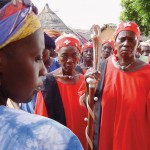Dir. by Ousmane Sembene
Sembene introduced his film by reminding his mostly white, mostly Western audience that Africa — the entire continent, its nations, its governments, and its people — is experiencing a period of unprecedented transition. There was no moralizing or condemnation in his tone, not even a suggestion of the catastrophic crises and genocides that fill the back pages of our newspapers. Africa is in transition, he told us, and this film is about that transition.
By the time it reached Toronto, Moolaadé was already the talk of the festival, having garnered much acclaim at Cannes from such influential voices as Roger Ebert, who is actively campaigning on its behalf. I knew only that it was a film about the traditional practice of salinde, or female circumcision, that Sembene was generally known as the “grandfather of African cinema,” and that several of my friends were jealous of my getting a ticket to the sold-out screening. In fact, genital mutilation is but one of the film’s many concerns. The salinde serves more generally as a site of contention between the women who, newly empowered by the creeping influence of Western humanism and technology, begin to rebel against the patriarchal structures of their society — salinde is a site of contention between these strong, young women and the men who wish to maintain their patriarchal hold on power.
Collé (Fatoumata Coulibaly) is a second wife who, still scarred from her own circumcision, had refused years earlier to have her only daughter “cleansed.” In the opening moments of the film, four young girls come to Collé for similar protection, and she obliges, instituting a moolaadé, or a ceremonial zone of refuge. Her decision sets in motion the principle conflicts in the film: the older generation of women (particularly those who perform the ritual) vs. those women who oppose it; the men of the village whose identity is founded on traditional notions of masculinity vs. those who offer an alternate model (the Western-educated son or the big city mercenary); and, more simply, the old (including a particular interpretation of Islam) vs. the new (symbolized by the ubiquitous radios that blare from all corners of the village).
By the standards with which I typically judge a film, Moolaadé is too sentimental and predictable, and its performances are uneven, at best. (The notable exception being Coulibaly, who delivers my favorite performance of the year.) And yet watching Moolaadé is a gut-churning experience, in part, I suspect, because of its close proximity to “reality.” Sembene told us that he shot on location in a typical West African village and that he cast untrained locals in many of the speaking parts. These particular young women that we watch on screen represent thousands of others just like them, and their very real investment in the “transition” is apparent.
I hope this is a fair comparison — I always worry about applying Western models to non-Western stories, imperializing them, so to speak — but as I watched Moolaadé I was reminded of certain American literatures of the late-19th century, another significant period of transition. If Moolaadé is didactic, then its didacticism might be forgiven: What value, after all, can be found in the other side of the genital mutilation (or slavery or suffrage) debate? And, a question of even greater value, I think: When is unbridled emotionalism (which I often too casually dismiss as “sentiment”) a perfectly appropriate and even politically resonant response to particular conditions? The emotional trajectory of Moolaadé reaches its climax when Collé is punished for her transgressions. It’s a brutal scene, but I found myself more deeply moved by a more quiet moment that followed. It’s the sound of a crying mother. That’s it. A crying mother. And it worked, breaking through my cynicism and emotional distance. Highly recommended.
